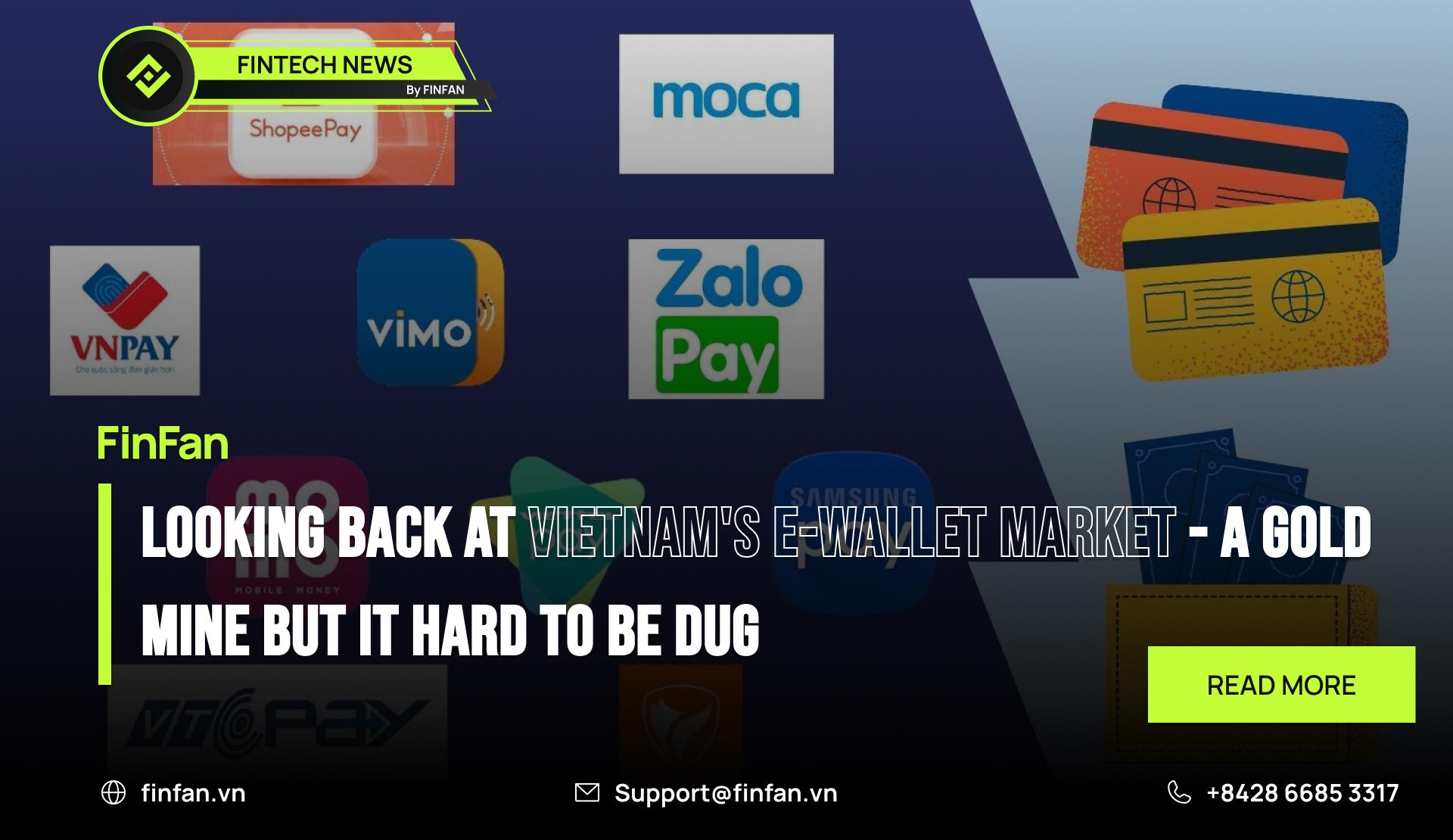Looking back at Vietnam's e-wallet market Part 1 - a gold mine but the big guys still report losses

FinFan has discussed many articles about e-wallets in the Vietnam market. Notably in the series of articles, FinFan mentioned the top 3 most used e-wallets in Vietnam. Among those 3 giants, only VNPay reported a profit until around the end of 2021 and is predicted to continue according to the latest article on the popular e-newspaper for business and finance CafeBiz.
What has happened to the top users of e-wallets in Vietnam? In this article, we will find the answer to this.
Zalo Pay and MoMo, the two giants with the largest number of users in the market and their strengths.
Zalo Pay - a giant expanding the market in a form similar to China's WeChat Pay
Although it was born later than MoMo (around 2016). However, with strong support from Vina Game Group (VNG) along with the network of users of Vietnam's leading messaging social network, Zalo.
Zalo Pay gradually conquered the market and achieved initial success in the number of users, reaching the top of the most used e-wallets in Vietnam.
It can be said that Zalo Pay's development model is updated and developed based on the very successful development model of WeChat Pay in the Chinese market because they are similar in the following 3 characteristics:
- They both release free messaging social networks that are used by most people.
If WeChat Pay is developed based on the fastest growing and most widely used messaging social networking platform in China, WeChat, Zalo is also the perfect stepping stone for the success of the e-wallet with the same name. with this number 1 free messaging tool in Vietnam.
- They all started from a starting point and were invested by a technology company that was quite strong in the field of online games and online card recharging in the past.
The reason WeChat Pay is growing so strongly in the Chinese market is that they are a subsidiary of a technology corporation that started as a distributor of famous online games and was successful with its recharge cards to upgrade items in the gamecard to upgrade equipment in the game when it was formerly Tencent.
That proves they have also been successful with the payment gateway model to serve their game development.
The e-wallet development model is similar, creating a free messaging tool to benefit the majority of domestic users, and then creating a payment model to support the need for payments when shopping online of the above users.
At the same time, it opens an era of multi-channel development that does not stop at the message social network model.
The facts have proven that the Chinese TikTok online business model called Douyin has been developed very well by Tencent and has become a wave of market development.
Going back to Zalo Pay's development model is the same, VinaGames has been very successful and has been an extremely large competitive force for VTC in the past.
Up to now, VinaGames has also become a leader in the Vietnamese gaming industry and at the same time, a few subsidiaries of VinaGames and other technology segments such as Zalo and Zalo Pay of Zion are also gradually leading in its own market.
- VinaGames and Tencent are both trendy giants.
Starting out as two companies developing online games for PC, these two giants still took the opportunity in their own domestic market to expand into the mobile app market to develop catch-up platforms that keep up with the trend.
They are even companies that open up new trends and trends for the market such as the trend of online gaming from the 2000s until today or the trend of short video social networks of Douyin (TikTok China) has spread around the world.
In particular, the trend of just typing commands on Zalo to be able to pay on Zalo Pay or in China, WeChat and WeChat Pay has created a big step forward for the payment industry in their country.
MoMo - a giant and pioneer in the e-wallet market
Starting in 2014 when the smartphone market began to become popular in Vietnam, MoMo was born and was the first application to apply payment for everything using just a mobile app in the Vietnamese market.
With its very smart strategy, MoMo quickly conquered a large number of users at the beginning and quickly led the market in terms of users until now with more than 56% of active users.
If the strength of Zalo Pay comes from taking advantage of the growth of VinaGames as well as the development of the Zalo messaging social network, the strength of MoMo can come from the following 3 factors:
- Combined with the largest banks in Vietnam first
Right from the first days of launching on the market, banking giant Vietcombank began to pay attention to MoMo and let this company test its payment service by connecting directly to MoMo's system (remember, Vietcombank is one of the Big 4 banks in Vietnam).
With the help of Vietcombank, MoMo has also partly conquered the majority of customers using services at this bank. Also from that time, MoMo had more advantages in accessing and connecting its services with other large banks, and also received investment from large banking-related funds such as Goldman Sachs and Standard Chartered.
- Choose services that are very suitable for young people, which the most potential customers for the e-wallet field
MoMo is a pioneering e-wallet in the fields of paying for movie tickets, food stores, and a number of youth-related services such as (paying bus tickets, paying university tuition, etc.).
In 2021, realizing that the Buy Now Pay Later model has great potential (especially for young people), MoMo proactively linked up with TPBank to open the "Laterpay Wallet" application for customers using its connected services.
MoMo is also one of the first e-wallet companies to link with food delivery apps that are popular with young people such as Grab, Gojek, Be, etc., and coordinate with them to launch incentive programs when ordering food on those food delivery apps.
- Create unique user-attractive programs.
MoMo always creates campaigns to attract users as well as motivate them to interact with each other on their own applications such as "Raising pigs on the app to receive rewards", "Jogging to receive rewards".
This makes customers not only think of MoMo as a boring money transfer app like a bank, but also as a place for them to entertain as well as perform other socially useful work such as money donation programs for foundations. donate to charity or donate raised pigs to those funds.
Zalo Pay and MoMo - Why are the two giants above both losing money?
Despite having obvious strengths, why do the above giants still suffer losses in the market? That could come from the following 3 reasons:
- First, the demand for shopping or ordering food online due to COVID-19, both Zalo Pay and MoMo lost market share to Shopee Pay.
The sound of ambulances and checkpoints set up to limit traffic and movement between established routes were the most noticeable things during the years when the COVID-19 pandemic raged very hard throughout Vietnam.
At that time, people's needs shifted to the last level of Maslow's pyramid (having enough to wear and stay healthy), and they couldn’t go directly to the store to buy something, so they needed to shop more than use these direct payment apps.
This greatly affects the income and revenue of e-wallets in general and MoMo and Zalo Pay in particular. On the other side, Shopee took this opportunity to expand its e-commerce channel as well as its online food delivery app.
It is also an opportunity for Shopee Pay to grow revenue when both sellers and buyers use this wallet to enjoy the incentives that Shopee brings to them through ordering or ordering food online.
- Second, the opportunity for branding instead of having short revenue.
However, in these difficult times, there is also an opportunity for these e-wallets to strengthen brand recognition with their customers. All the big guys in the industry clearly understand the golden time during this crisis and spend heavily on this issue.
Compared to Shopee Pay and Moca receiving support from giants in the e-commerce and multi-utility app industry. E-wallets that are not products in the utility system such as MoMo and Zalo Pay must spend even more heavily to attract customers to use the service with their inherent strengths.
The results show that, despite losses of up to 800 billion VND as in the case of MoMo or 1,200 billion VND as in the case of Zalo Pay, these two giants are still at the top in attracting customers, accounting for more than 56% of the market respectively share for MoMo and Zalo Pay accounts for 14% of the market share (as of the end of 2021).
- Expand cooperation opportunities with other fast food delivery parties or brand chains that do not pay too much attention to e-commerce platforms.
Besides the opportunity to expand brand recognition, this is also an opportunity for both Zalo Pay and MoMo to expand their utility to other food delivery apps such as Gojek, Be, Baemin, etc., to increase competitiveness with Shopee Food and GrabFood.
Furthermore, some brands that do not consider the Shopee e-commerce platform as the main distribution channel (expensive fashion, handicrafts, expensive cosmetics) are the source of partners that MoMo and Zalo Pay will target when Shopee focuses too much on creating an ecosystem instead of caring about these customers.
Sharing incentives with food delivery apps as well as with the above shops has also contributed to reducing the revenue of these two e-wallet market giants.
Why did VNPay in the hardest time still have an interest?
MoMo and Zalo Pay are still trying to attract potential customers to use their wallets and operate according to the B2B2C model. This model will encounter difficulties when one of the two parties, the final customer or partner business, has financial difficulties.
Another big player in the market, VNPay, is still profitable thanks to the method of cooperation with large businesses under the B2B model.
At that time, attracting final customers to use their payment method will largely be the responsibility of the business with which VNPay has cooperated.
A typical example is the outstanding growth of the Coop-Mart and Coop-Food supermarket chains during the epidemic season, which also contributed significantly to the revenue of VNPay when Coop-Mart signed an exclusive partnership with VNPay.
Accordingly, customers who buy products at VNPay will receive attractive incentives from the oldest supermarket chain in the country.
Another example is that the information portals of Tax Authorities as well as the CIC system of the State Bank have all reached an agreement with VNPay to use this e-wallet as their online method.
This article was curated and authored by FinFan's market research and development team, alongside our marketing department.
About FinFan
FinFan is a cross-border embedded financial services company that focuses on mass disbursement, fund collection, card processing, IBAN, and digital APMs solutions, which can provide valuable input and integration on and for the same.
FinFan is already integrated with almost the world's well-known MTOs, PSPs, switch, and core fintech platforms such as Money Gram, Thunes, Qiwi, Remitly, World Remit, Bancore, PaySend, Terrapay, Ria Money Transfer (Euronet), Dlocal, Ripple, TripleA, FoMo Pay, Wings, etc.
For more information, please get in touch with us through:
🌐https://finfan.io
📞(+84) 2866 85 3317
✉ support@finfan.vn
LinkedIn: FinFan





